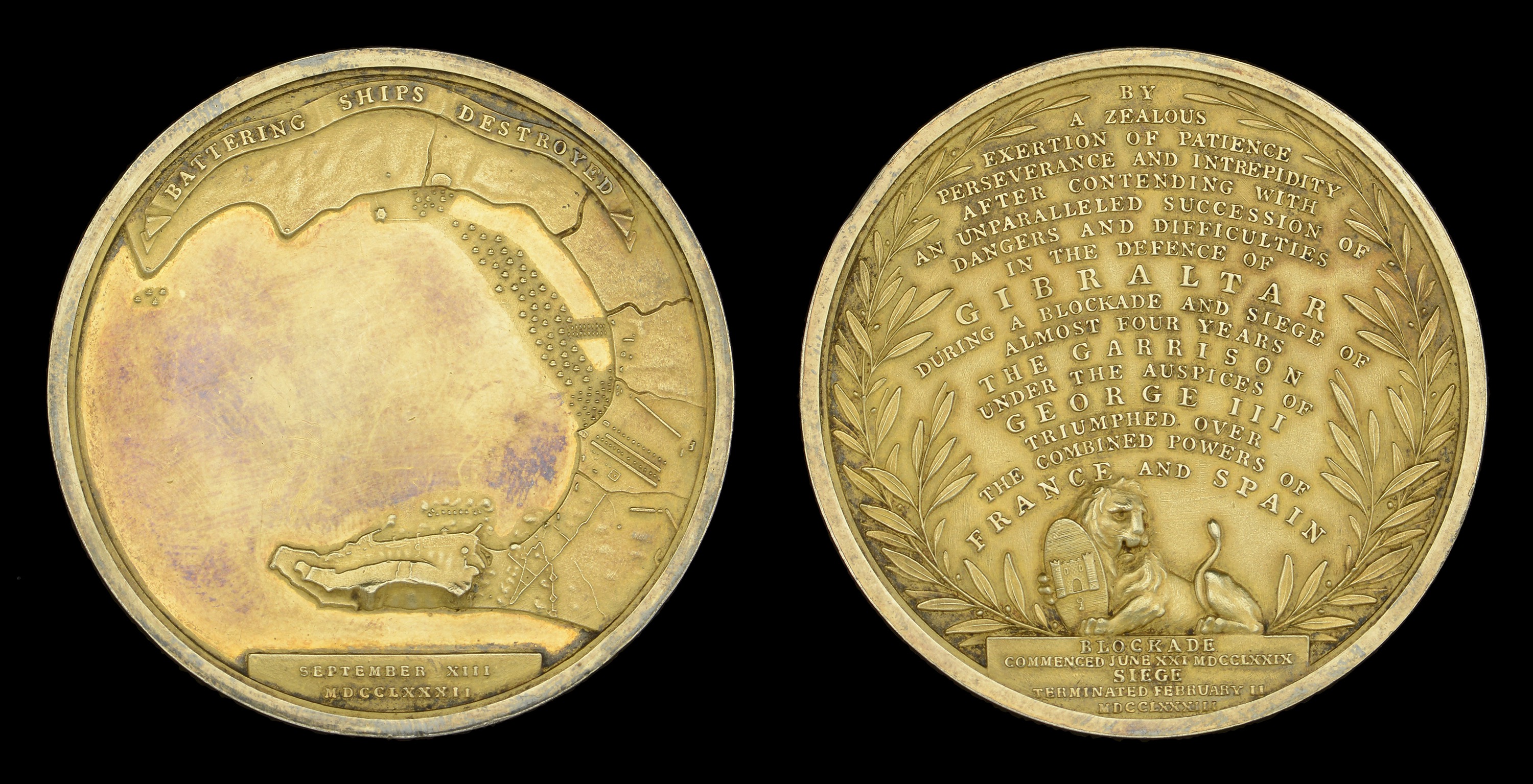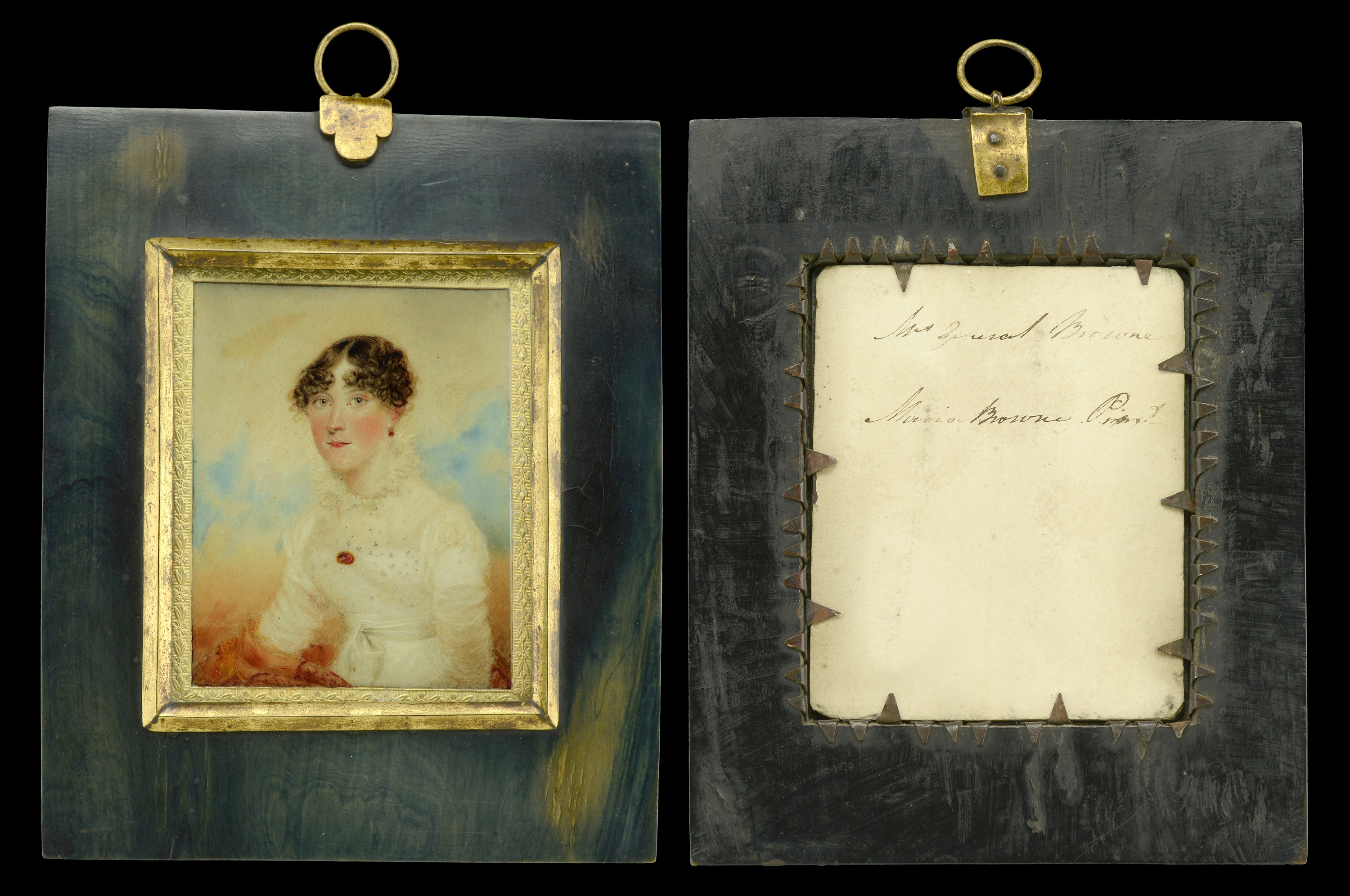The Browne Family’s Picton Medal for the Defence of Gibraltar, contemporarily gilded and named to the American-born Major Arthur Browne, 58th Foot, who was standing beside General Wolfe when he was mortally wounded on Quebec’s Plains of Abraham; he defended Gibraltar throughout the Great Siege and commanded Ireland’s largest Military Fortification during the United Irishmen uprising - his medal passed down the remarkable Browne family, whose extensive network of international connections spanned North America, Ireland and India Defence of Gibraltar 1779-83, General Picton’s Medal, silver, with later but still contemporary gilding, fitted within an additional silver rim, 59mm, the edge with contemporary inscription ‘This Medal presented in 1784 to Major Arthur Browne, 58th Regt. for his services during this Memorable Siege and by him when Lt. Govr. of Kinsale to his eldest Son Thomas Browne Lt. Col. 69th Regt. and a Colonel in the Army’, this inscription and the gilding dating from 1810-12, some rubbing to the edge, otherwise nearly extremely fine and very rare Together with a related Portrait Miniature of Mrs. Thomas Browne, painted by her sister-in-law Maria Bellet Browne, circa 1816, 90mm x 71mm, in original Indian horn frame with gilt brass hanger, 168mm x 140mm overall, signed M B Browne and inscribed on the reverse ‘Mrs General Browne/Maria Browne Pinxt’, good original condition (2) £3,000-£4,000 --- Provenance: Dix Noonan Webb, September 2004 (Medal); Mellors & Kirk, February 2022 (Portrait). Arthur Browne was born in 1743 at Portsmouth, New Hampshire, in what was then British North America, the third son among eight siblings. His father, the Reverend Arthur Browne (1699-1773), was of Scottish ancestry and Irish parentage, and had been born in Drogheda, Ireland. After marriage and ordination, he was expatriated to America in 1729 by the Society for Propagating the Gospel in Foreign Parts. Arthur Senior had a degree from Trinity College Dublin and was a prominent citizen of Portsmouth, a prosperous Anglican minister and a Tory. His status as a leading New England dignitary is confirmed in a 1757 quarter-length portrait by John Singleton Copley. With Wolfe at the Battle of the Plains of Abraham, Quebec On 7 February 1759, aged about 16, Arthur Browne entered military service as a Lieutenant-Fireworker, an artillery officer equivalent to an Ensign. This was probably due to the influence of a relative, Brigadier-General George Williamson, who commanded the Royal Artillery in North America. In the Spring of 1759, Browne embarked with General Wolfe’s expedition to take Quebec. During the Battle of the Plains of Abraham on 13 September 1759, Browne was summoned to act as Brigadier Williamson’s Brigade-Major (Aide de Camp in the field). Lieutenant Browne took post beside Williamson and Wolfe on a small rise near the positions of the 28th Foot and the Louisbourg Grenadiers. Wolfe chose the spot as it enabled him to better observe the attack made by the French under the command of the Marquis de Montcalm. The French forces included about 2,000 irregulars who were good shots and used to guerilla warfare. Wolfe’s command group made a conspicuous target, and early on Wolfe was wounded in the wrist. He allowed the French line to advance within 30 yards of the British before giving the order to fire. Within a few moments he had been hit twice, in the stomach and, mortally, in the chest. The French turned and fled, while a cry went up "They run, see how they run." Wolfe, on the ground, opened his eyes and asked who was running. Upon being told that the French had broken, he turned on his side and said "Now, God be praised, I will die in peace" and expired. The victorious British force spent a miserable winter in the captured city, losing men from scurvy and disease. By the spring of 1760 the garrison had shrunk to 4,000 regulars and before the ice melted Montcalm’s successor marched to Quebec with 7,000 men, aiming to recapture the city before British ships could return with vital supplies and reinforcements. On 28 April 1760, 3,000 men with 22 guns left the city to attack the French at the Heights of Abraham. Arthur Browne was in command of two six-pound field guns and attached to the 35th Regiment. During the battle, Browne was ordered to take one of his guns forward to support Captain Ince’s grenadier company. The grenadiers were massacred, with Ince and 54 men becoming casualties (out of a total of 64 - 86% losses). Two of Browne’s gun team were killed, four wounded and Browne was himself wounded in the hip. The British attack failed completely, with the loss of 1,100 troops and their guns. The survivors retired within the city walls. A month later the British fleet arrived, the French lifted their siege and retreated to Montreal. Further Service in the Seven Years War Soon afterwards, Lieutenant-Colonel William Howe of the 58th Foot (later Commander-in-Chief in America during the Revolutionary War) invited Browne to leave the artillery and join his regiment. On 18 October 1760 Browne was gazetted an Ensign in the 58th Foot. After the capture of Canada was completed, the 58th marched via Lake Champlain to New York. In 1762 the 58th Foot was part of a reinforcement, which, despite the loss of 500 men to French naval attacks while en route from North America, was decisive in enabling the storming of the great Morro Fortress that guarded the entrance to Havana bay and thus the subsequent capture of Havana, the capital of the Spanish West Indies. In February 1763 Browne commanded a detachment of the 58th serving as marines on board H.M.S. Ripon (60). On 29 April 1763 Browne purchased a Lieutenancy in the 58th Foot. After the Peace in 1763, the 58th moved to Ireland. Browne bought a Captain-Lieutenancy in 1770. The Great Siege of Gibraltar In June 1770 Spain forced the British to leave their settlement in the Falkland Islands. The colony was quickly re-established, but the countries nearly declared war. The 58th Foot embarked at Cork and was sent to strengthen the garrison of Gibraltar. Arthur purchased his company in April 1772 aged 29, becoming Captain Browne. Spain entered the American War of Independence on 16 June 1779, at a time when the British were hard pressed. Within a week, Spain began its blockade of Gibraltar. The small (5,400 man) garrison under Governor-General George Eliott was hampered by shortages of men and supplies. Despite these difficulties, Eliott mounted a vigorous defence. Many of the infantry were hand-picked to assist the artillery in serving the guns. Given Browne’s previous artillery experience, he is thought to have been among them. He received his second wound, a severe contusion caused by a shell-splinter, but remained on duty. During the winter of 1779 the garrison began to suffer from lack of fresh provisions, which caused a debilitating outbreak of scurvy among the troops. Small quantities of salt meat and biscuits were the standard meal, with an occasional issue of four ounces of rice as a full day's ration. Due to lack of fuel, fires were only made with difficulty, using salt-encrusted timbers from old ships. Despite their privations, morale remained high, and the troops continued to take their turns in the trenches and batteries. In January 1780 Admiral Rodney defeated the Spanish screening squadron and replenished the Rock with 1,000 reinforcements and a limited quantity of essential supplies. The Spanish stepped up the bombardment and blockade, which was broken a second time by Admiral Darby in April 1781. By this time the garrison consisted of 7,000 British and Hanoverian regulars. The French and Spanish...









